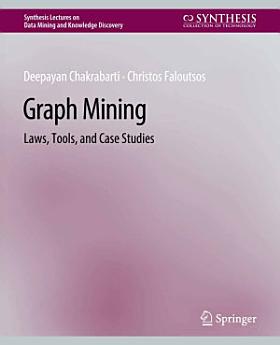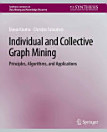Graph Mining: Laws, Tools, and Case Studies
May 2022 · Springer Nature
Ebook
191
Pages
reportRatings and reviews aren’t verified Learn More
About this ebook
What does the Web look like? How can we find patterns, communities, outliers, in a social network? Which are the most central nodes in a network? These are the questions that motivate this work. Networks and graphs appear in many diverse settings, for example in social networks, computer-communication networks (intrusion detection, traffic management), protein-protein interaction networks in biology, document-text bipartite graphs in text retrieval, person-account graphs in financial fraud detection, and others. In this work, first we list several surprising patterns that real graphs tend to follow. Then we give a detailed list of generators that try to mirror these patterns. Generators are important, because they can help with "what if" scenarios, extrapolations, and anonymization. Then we provide a list of powerful tools for graph analysis, and specifically spectral methods (Singular Value Decomposition (SVD)), tensors, and case studies like the famous "pageRank" algorithm and the "HITS" algorithm for ranking web search results. Finally, we conclude with a survey of tools and observations from related fields like sociology, which provide complementary viewpoints. Table of Contents: Introduction / Patterns in Static Graphs / Patterns in Evolving Graphs / Patterns in Weighted Graphs / Discussion: The Structure of Specific Graphs / Discussion: Power Laws and Deviations / Summary of Patterns / Graph Generators / Preferential Attachment and Variants / Incorporating Geographical Information / The RMat / Graph Generation by Kronecker Multiplication / Summary and Practitioner's Guide / SVD, Random Walks, and Tensors / Tensors / Community Detection / Influence/Virus Propagation and Immunization / Case Studies / Social Networks / Other Related Work / Conclusions
About the author
Dr. Deepayan Chakrabarti obtained his Ph.D. from Carnegie Mellon University in 2005. He was a Senior Research Scientist with Yahoo, and now with Facebook Inc. He has published over 35 refereed articles and is the co-inventor of the RMat graph generator (the basis of the graph500 supercomputer benchmark). He is the co-inventor in over 20 patents (issued or pending). He has given tutorials in CIKM and KDD, and his interests include graph mining, computational advertising, and web search. Christos Faloutsos is a Professor at Carnegie Mellon University and an ACM Fellow. He has received the Research Contributions Award in ICDM 2006, the SIGKDD Innovations Award (2010), 18 "best paper" awards (including two "test of time" awards), and four teaching awards. He has published over 200 refereed articles, and has given over 30 tutorials. His research interests include data mining for graphs and streams, fractals, and self-similarity, database performance, and indexing for multimedia and bio-informatics data.
Rate this ebook
Tell us what you think.
Reading information
Smartphones and tablets
Install the Google Play Books app for Android and iPad/iPhone. It syncs automatically with your account and allows you to read online or offline wherever you are.
Laptops and computers
You can listen to audiobooks purchased on Google Play using your computer's web browser.
eReaders and other devices
To read on e-ink devices like Kobo eReaders, you'll need to download a file and transfer it to your device. Follow the detailed Help Center instructions to transfer the files to supported eReaders.





